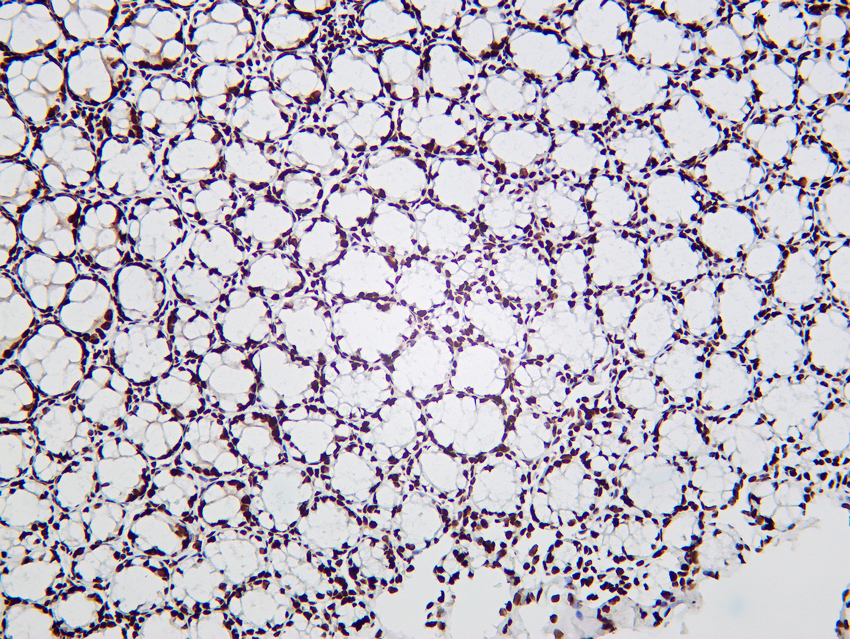HDAC2 (PT0063R) PT® Rabbit mAb
- Catalog No.:YM8033
- Applications:WB;IHC;IF;IP;ELISA
- Reactivity:Human; Mouse; Rat;
- Target:
- HDAC2
- Fields:
- >>Cell cycle;>>Longevity regulating pathway - multiple species;>>Notch signaling pathway;>>Neutrophil extracellular trap formation;>>Thyroid hormone signaling pathway;>>Huntington disease;>>Amphetamine addiction;>>Alcoholism;>>Human papillomavirus infection;>>Epstein-Barr virus infection;>>Pathways in cancer;>>Transcriptional misregulation in cancer;>>Viral carcinogenesis;>>MicroRNAs in cancer;>>Chronic myeloid leukemia
- Gene Name:
- HDAC2
- Protein Name:
- Histone deacetylase 2
- Human Gene Id:
- 3066
- Human Swiss Prot No:
- Q92769
- Mouse Gene Id:
- 15182
- Mouse Swiss Prot No:
- P70288
- Specificity:
- endogenous
- Formulation:
- PBS, 50% glycerol, 0.05% Proclin 300, 0.05%BSA
- Source:
- Monoclonal, rabbit, IgG, Kappa
- Dilution:
- IHC 1:200-500,WB 1:1000-5000,IF 1:200-1000,ELISA 1:5000-20000,IP 1:50-200
- Purification:
- Protein A
- Storage Stability:
- -15°C to -25°C/1 year(Do not lower than -25°C)
- Other Name:
- HDAC2;Histone deacetylase 2;HD2
- Molecular Weight(Da):
- 55kD
- Observed Band(KD):
- 55kD
- Background:
- This gene product belongs to the histone deacetylase family. Histone deacetylases act via the formation of large multiprotein complexes, and are responsible for the deacetylation of lysine residues at the N-terminal regions of core histones (H2A, H2B, H3 and H4). This protein forms transcriptional repressor complexes by associating with many different proteins, including YY1, a mammalian zinc-finger transcription factor. Thus, it plays an important role in transcriptional regulation, cell cycle progression and developmental events. Alternative splicing results in multiple transcript variants. [provided by RefSeq, Apr 2010],
- Function:
- catalytic activity:Hydrolysis of an N(6)-acetyl-lysine residue of a histone to yield a deacetylated histone.,function:Forms transcriptional repressor complexes by associating with MAD, SIN3, YY1 and N-COR. Interacts in the late S-phase of DNA-replication with DNMT1 in the other transcriptional repressor complex composed of DNMT1, DMAP1, PCNA, CAF1.,function:Responsible for the deacetylation of lysine residues on the N-terminal part of the core histones (H2A, H2B, H3 and H4). Histone deacetylation gives a tag for epigenetic repression and plays an important role in transcriptional regulation, cell cycle progression and developmental events. Histone deacetylases act via the formation of large multiprotein complexes.,sequence caution:Intron retention.,similarity:Belongs to the histone deacetylase family. Type 1 subfamily.,subunit:Interacts with the non-histone region of H2AFY (By similarity
- Subcellular Location:
- Nuclear
- Expression:
- Widely expressed; lower levels in brain and lung.
Differential gene regulatory plasticity between upper and lower layer cortical excitatory neurons. MOLECULAR AND CELLULAR NEUROSCIENCE 2018 May 23 WB Mouse brain
Differential gene regulatory plasticity between upper and lower layer cortical excitatory neurons. MOLECULAR AND CELLULAR NEUROSCIENCE 2018 May 23 WB Mouse brain
A novel selenium analog of HDACi-based twin drug induces apoptosis and cell cycle arrest via CDC25A to improve prostate cancer therapy Theranostics Zhiyong Shi WB Mouse,Human PC3 PCa cell-Xenograft PC3 cell
- June 19-2018
- WESTERN IMMUNOBLOTTING PROTOCOL
- June 19-2018
- IMMUNOHISTOCHEMISTRY-PARAFFIN PROTOCOL
- June 19-2018
- IMMUNOFLUORESCENCE PROTOCOL
- September 08-2020
- FLOW-CYTOMEYRT-PROTOCOL
- May 20-2022
- Cell-Based ELISA│解您多样本WB检测之困扰
- July 13-2018
- CELL-BASED-ELISA-PROTOCOL-FOR-ACETYL-PROTEIN
- July 13-2018
- CELL-BASED-ELISA-PROTOCOL-FOR-PHOSPHO-PROTEIN
- July 13-2018
- Antibody-FAQs
- Products Images

- Various whole cell lysates were separated by 4-20% SDS-PAGE, and the membrane was blotted with anti-HDAC2(PT0063R) antibody. The HRP-conjugated Goat anti-Rabbit IgG(H + L) antibody was used to detect the antibody. Lane 1: C6 Lane 2: Hela Lane 3: NIH-3T3 Lane 4: K562 Lane 5: A431 Lane 6: HepG2 Predicted band size: 55kDa Observed band size: 55kDa

- Mouse colon was stained with Anti-HDAC2 (PT0063R) rabbit antibody

- Rat spleen was stained with Anti-HDAC2 (PT0063R) rabbit antibody

- Human tonsil was stained with Anti-HDAC2 (PT0063R) rabbit antibody



